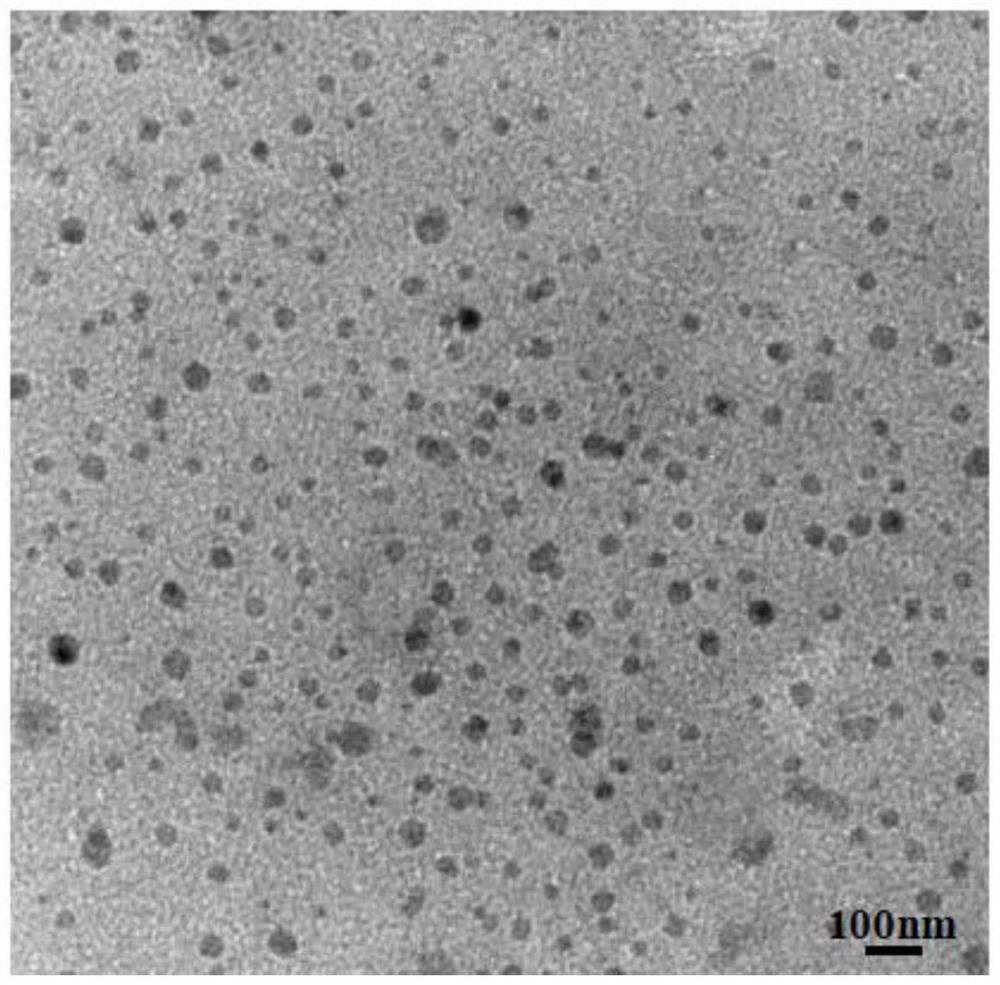A fa-cus/ce6-gd nano-diagnosis and treatment probe of conjugated gadolinium and its preparation method and application
A ce6-gd, nanotechnology, applied in the preparations for in vivo experiments, general/multifunctional contrast agents, medical preparations with inactive ingredients, etc. The rate and penetration depth are low, not enough to kill tumor cells, etc., to achieve the effect of good dispersion and biocompatibility, and wide application prospects.
- Summary
- Abstract
- Description
- Claims
- Application Information
AI Technical Summary
Problems solved by technology
Method used
Image
Examples
preparation example Construction
[0042] A kind of preparation method of the FA-CuS / Ce6-Gd nanometer diagnosis and treatment probe of conjugated gadolinium, the method comprises the following steps:
[0043] S1: Synthesis of amino-modified CuS nanoparticles;
[0044] in CuCl 2 2H 2 In the aqueous solution of O, add a certain mass of HS-PEG-NH 2 , adjust the pH of the solution to 9.0-10.0 through NaOH solution, and then add thioacetamide (CH 3 CSNH 2 ) into the mixed solution, heated the mixture to 50-70°C, reacted for 2-4 hours, left to cool, washed by ultrafiltration, and washed three times with phosphate buffered saline solution to obtain amino-modified water-soluble CuS nanoparticles, HS -PEG-NH 2 The molecular weight is 2000;
[0045] S2: Preparation of Ce6-modified CuS nanoparticles;
[0046] Dissolve Ce6 in DMSO at a concentration of 1 mg / mL, add 1-(3-dimethylaminopropyl)-3-ethylcarbodiimide hydrochloride (EDC) and N-hydroxysuccinyl Amine (NHS) was stirred at room temperature for 2-4 hours; the a...
Embodiment 1
[0052] Formation of amino-modified CuS template: 9 mg CuCl 2 2H 2 O was dissolved in 12mL ultrapure water, and 21mgHS-PEG-NH 2 , add 1M NaOH solution dropwise, adjust the pH of the solution to 9.0, then add 8mg thioacetamide to the mixed solution, heat the mixture to 50°C, react for 2h, ultrafilter, wash with PBS (molecular weight cut off 10KDa, 5000rpm ) three times to get H 2 N-PEG-CuS NPs. figure 2 and Figure 4 respectively H 2 The transmission electron microscope image of N-PEG-CuS NPs and the size distribution image under dynamic light scattering, it can be seen that the H 2 The particle diameter of N-PEG-CuS NPs is about 30 nm. Figure 4 In , the ordinate is the number of nanoparticles, and the abscissa is the size of the particle diameter.
Embodiment 2
[0054] S1: Refer to Example 1 for the formation of amino-modified CuS templates.
[0055] S2: Ce6 activation: 6.3 mg of chlorin e6 was dissolved in dimethylsulfoxide at a concentration of 1 mg / mL, and 40.3 mg of 1-(3-dimethylaminopropyl)-3-ethylcarbodiimide was added Hydrochloride (EDC) and 24.2mg of N-hydroxysuccinimide (NHS) were stirred at room temperature for 2h.
[0056] S3: Ce6 modified CuS nanoparticles: Add the activated chlorin e6 solution to the CuS solution, stir overnight in the dark, wash with ultrafiltration water to remove the organic solvent dimethyl sulfoxide and unreacted Ce6, and collect CuS / Ce6 nanoparticles.
[0057] S4: Folic acid modification of CuS nanoparticles: Add 21 mg of HS-PEG-FA aqueous solution to the aqueous solution of CuS-Ce6 nanoparticles obtained in step S3, mix and stir for 6 hours, wash with ultrafiltration water three times, and couple folic acid to CuS through sulfhydryl groups the surface of the nanoparticles.
[0058] S5: Gd 3+ C...
PUM
| Property | Measurement | Unit |
|---|---|---|
| diameter | aaaaa | aaaaa |
Abstract
Description
Claims
Application Information
 Login to View More
Login to View More - R&D
- Intellectual Property
- Life Sciences
- Materials
- Tech Scout
- Unparalleled Data Quality
- Higher Quality Content
- 60% Fewer Hallucinations
Browse by: Latest US Patents, China's latest patents, Technical Efficacy Thesaurus, Application Domain, Technology Topic, Popular Technical Reports.
© 2025 PatSnap. All rights reserved.Legal|Privacy policy|Modern Slavery Act Transparency Statement|Sitemap|About US| Contact US: help@patsnap.com



